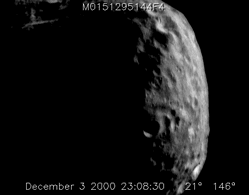| ERHS PHYSICS
Chapter 8.2 Notes |
||||
|
|
||||
Lets take a look at some of the other aspects of satellite behavior. To do so, we will use various combinations of Kepler's Third Law and Newton's Law of Universal Gravitation, and our recently acquired knowledge of centripetal motion.
First... remember this formula from section 8.1 (formula #11 on that page.)? ![]()
This relationship can be solved for the period T of any satellite of an object with mass m1, at a distance r from the center of that mass.
1. ![]() and
and
2. ![]()
So.. note that for any given orbital radius r, there is only one value of period T that is valid, that value calculated by formula #2 above. If a satellite has a constant orbital radius and therefore covers a specific circumference in period T, the satellite must have a specific velocity that works for that particular radius. By this I mean.. for any given orbital radius r, there appears to be only ONE velocity at which any satellite of any kind can travel. Lets explore this a little more.
In the section on centripetal motion in chapter 7 we learned that
5. ![]() . Substituting this value in to equation 4 above, we see that
. Substituting this value in to equation 4 above, we see that
6. ![]() . Multiply both sides by r, and take the square root to arrive at
. Multiply both sides by r, and take the square root to arrive at
7. ![]()
You try:
Now.. one last formula for velocity of a satellite...
In formula #11 from the previous section, we saw that Kepler's constant for an orbital system could be expressed as
8. ![]() . Lets assign this constant to the symbol k for now such that
. Lets assign this constant to the symbol k for now such that
9. ![]() . Note that now
. Note that now
10.![]() . If we substitute this value into velocity formula #7 above we see that
. If we substitute this value into velocity formula #7 above we see that
11.![]() .
.
Weight and weightlessness.
Ok.. consider an astronaut in the space shuttle. You have all seen video of them moving around as if they have no weight at all. Yet, Universal Gravitation clearly indicates that a gravitational force of attraction (weight) exists. Also, you can calculate the acceleration rate g as
![]() as we saw in the previous section.
as we saw in the previous section.
The shuttle is at about 400 km above the surface of the Earth. Add that value to the radius of the Earth for "d" in this formula, and the mass of the Earth, and we find that the value of g at that altitude is -8.7 m/s/s.... only a little less than here on Earth. So what gives... why do those astronaut guys seem to be floating "weightlessly" ?
Simple..
Video: "The Apple and the Moon" from the Mechanical Universe Series.
You have seen that there you can calculate the value of g at any specific point from the center of the Earth. Imagine a collection of zillions of these points.
Einstein's theory of gravity
Albert Einstein theorized that gravity itself is not a force, but a behavior of space. He imagined that a mass would warp space around itself, thus bringing any objects in that space closer. So far, this General Theory of Relativity has proven to produce correct results every time it is tested. Relativity is a whole new ball game that we will not enter into at this point, but you should know its basic premise.
Activity: Project NEAR and Eros!
Homework: set #3 Ch8 questions 9-15 page 194 set #4 ch8 probs 41-49, page 195-96
video: "The Apple and the Moon" 15 min.